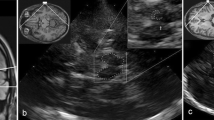Abstract
Transcranial sonography has become an important tool for the diagnosis of various movement disorders. In most patients with idiopathic Parkinson disease, a markedly hyperechogenic substantia nigra (SN) was detected on at least one side. We have highlighted the sonographic features that might help the differential diagnosis of PD and other movement disorders. Our investigation involved 30 patients (age 45–85 years) with idiopathic Parkinson disease, 2 multiple system atrophy, 3 progressive supranuclear palsy and 2 patients with restless legs syndrome. In accordance with several previous studies, we detected hyperechogenicity of the SN by TCS in 90 % of patients with idiopathic Parkinson disease. Subjects with a marked severity disease had a larger extent of the hyperechogenic SN signal. All progressive supranuclear palsy patients had an enlarged third ventricle and, in two cases, we observed the presence of hyperechoic areas in the lentiform nucleus. This last ultrasonographic feature was also seen in our patients with multiple system atrophy. TCS abnormalities of the SN, midbrain raphe and basal ganglia are characteristics of several movement and affective disorders. These features are less easily detected by other techniques, such as CT and MRI, which enable the exclusion of structural lesions, such as tumours and multi-infarct disease, because the physical principle differs from other imaging methods.




Similar content being viewed by others
References
Behnke S, Berg D, Naumann M, Becker G (2005) Differentiation of Parkinson’s disease and atypical parkinsonian syndromes by transcranial ultrasound. J Neurol Neurosurg Psychiatry 76:423–425
Berg D, Godau J, Walter U (2008) Transcranial sonography in movement disorders. Lancet Neurol 7:1044–1055
Kolevski G, Petrov I, Petrova V (2007) Transcranial sonography in the evaluation of Parkinson disease. J Ultrasound Med 26:509–512
Gaenslen A et al (2008) The specificity and sensitivity of transcranial ultrasound in the differential diagnosis of Parkinson’s disease: a prospective blinded study. Lancet Neurol 7:417–424
Martin WR, Wieler M, Gee M (2008) Midbrain iron content in early Parkinson disease: a potential biomarker of disease status. Neurology 70:1411–1417
Zecca L, Berg D, Arzberger T et al (2005) In vivo detection of iron and neuromelanin by transcranial sonography: a new approach for early detection of substantia nigra damage. Mov Disord 20(10):1278–1285
Michell AW, Lewis SJG, Foltynie T, Barker RA (2004) Biomarkers and Parkinson’s disease. Brain 127:1693–1705
Spiegel J et al (2006) Transcranial sonography and [123I] FP-CIT SPECT disclose complementary aspects of Parkinson’s disease. Brain 129:1188–1193
Sanzaro E, Iemolo F, Duro G, Malferrari G (2014) A new assessment tool for Parkinson disease. The nigral lesion load obtained by transcranial sonography. J Ultrasound Med 33:1635–1640
Rocchi L, Niccolini F, Politis M (2015) Recent imaging advances in neurology. J Neurol 262(9):2182–2194
Author information
Authors and Affiliations
Corresponding author
Ethics declarations
Conflict of interest
The authors declare that they have no conflict of interest.
Rights and permissions
About this article
Cite this article
Sanzaro, E., Iemolo, F. Transcranial sonography in movement disorders: an interesting tool for diagnostic perspectives. Neurol Sci 37, 373–376 (2016). https://doi.org/10.1007/s10072-015-2424-6
Received:
Accepted:
Published:
Issue Date:
DOI: https://doi.org/10.1007/s10072-015-2424-6




